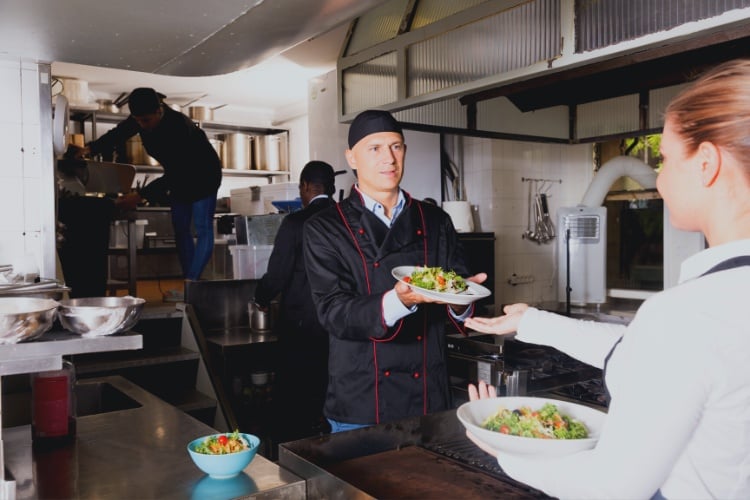Effective food safety practices don’t exist just for the benefit of food establishments, or even for the comfort of your customers.
The Food and Drug Administration (FDA) estimates that there are nearly 48 million cases of foodborne illnesses annually, meaning nearly one in six Americans gets sick from foodborne pathogens every year.1
The best way to protect your customers from foodborne illness is to create a kitchen culture that prioritizes food safety above all else. So in this article, we'll guide you on how to do just that. Let's break it down:
What is a positive food safety culture?
How to achieve a positive food safety culture in your kitchen
What is a positive food safety culture?
A positive food safety culture is the practice of prioritizing and paying detailed attention to best practices for food safety. This includes, but is not limited to, following time and temperature control guidelines, keeping allergens separate from non-allergenic foods, practicing good hygiene, and more.
All kitchens with a positive food safety culture share a few characteristics. First, every member of the team, from the establishment owner to the newest hire, must place a high level of importance on food safety. This can be taught through thorough food safety training.
There must also be clear leadership structures, open and honest communication, a team-oriented approach to service, and a suitable environment to heed all food safety best practices.
At its core, a positive food safety culture is a proactive food safety culture.
Read on for four ways you can develop a positive food safety culture in your own kitchen.
How to achieve a positive food safety culture in your kitchen
Lead by example
If you want your team to adopt certain behaviors, change needs to start at the top. Owners, operators, and managers should be extremely well-versed in food safety knowledge and should pay close attention to the day-to-day practices going on in the kitchen. Use mistakes as learning opportunities to teach kitchen staff more about food safety.
If you can provide team members with clear role models who are a regular presence in the kitchen, like a seasoned manager or head chef with exceptional food safety skills, you can expect others to begin adopting similar behaviors. Regular monitoring and consistency in food safety processes will make food safety a routine part of your kitchen!
Make sure your team understands the “why”
Simple corrections aren’t enough to make major kitchen changes stick. Ensure your entire kitchen team understands why certain changes are being implemented by sharing facts, re-wording examples to be relevant to your kitchen, and explaining real-life repercussions for unsafe actions. In addition to aiding in information recall, sharing the “why” behind food safety guidance will equip your team members with the knowledge to make better judgment calls when faced with unfamiliar situations.
Commitment to food safety comes from the inside out. Respecting food safety guidelines is a personal value that can be learned through thorough training at every level.
Implement a comprehensive training program
From the top to the bottom, all of your team members should be meticulously trained in food safety. It’s helpful to provide your entire team with the same training program so you can ensure they all walk away with comparable knowledge and skills. This will allow everyone to collaborate better in the kitchen, too!
Another best practice is to cover the cost of training for your team. Putting the financial impetus on your team members is a surefire way to de-incentivize them from completing the training and absorbing the information.
Listen to your team’s concerns
It’s one thing to tell your team they need to think about food safety best practices, but it’s another to make sure they’re actually equipped with the tools and knowledge they need to get the job done. If there are concerns from team members about equipment, prep space, or current kitchen practices, make sure to address them quickly. For example, if a team member feels they cannot properly separate allergenic and non-allergenic foods, it is best to provide them with another prep area as soon as possible. Understaffing is also a common issue that can lead to cutting food safety corners. An important part of developing a positive food safety culture is making sure your team feels heard and can safely bring concerns to management without repercussions.
Create accountability
At the end of the day, your management team won’t be able to watch every prep station or catch every food safety mistake. You’ll need to create systems that encourage accountability amongst the team.2 All types of rewards systems can encourage team members to follow through on food safety best practices, including progress trackers, quarterly celebrations, and calling out weekly food safety wins during team meetings.
Ultimately, making food safety a priority will improve guest satisfaction, online reviews, and word-of-mouth marketing for your establishment. The benefits to long-term revenue goals will most likely outweigh short-term losses incurred for new equipment and training. Consider the positive food safety culture you’ve implemented as an investment in the future of your kitchen, the careers of your team members, and the loyalty of your guests.
Sources:






.png)

.png)
